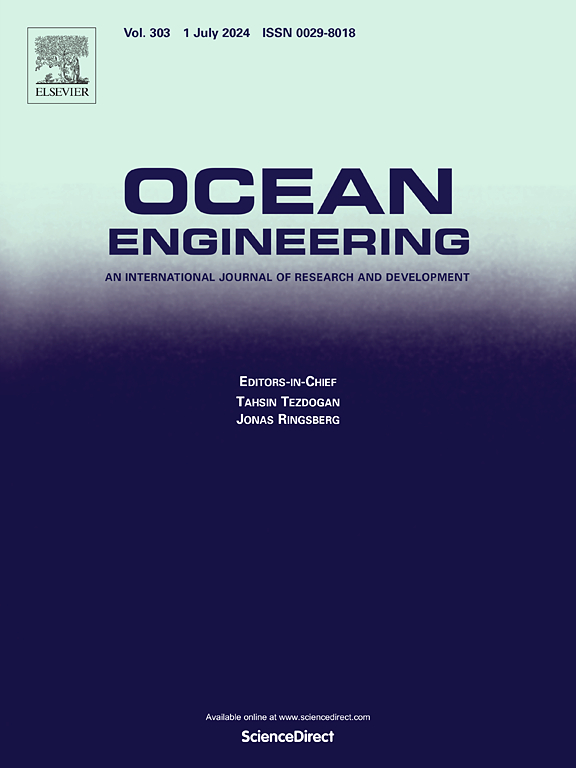静水压力下橡胶隔振器动态刚度的实验和数值分析
IF 4.6
2区 工程技术
Q1 ENGINEERING, CIVIL
引用次数: 0
摘要
由于橡胶隔振器具有阻尼和减振功能,而且成本相对较低,因此在航空航天、汽车和航海等行业得到了广泛应用。作为具有明显非线性行为的部件,准确预测隔振器的动态特性对于整体结构设计和振动噪声预测至关重要。虽然对橡胶隔振器的静态和动态性能进行了广泛的研究,但对某些特殊应用场景(如静水压力环境)下的性能研究还很有限。这些环境是真实存在的,例如,水下航行器的船首压载水箱中使用的隔振器可减轻武器发射过程中的振动。在这种情况下,隔振器不仅会受到振动时水介质增加质量的影响,还会受到随着深度增加而在隔振器表面增加的静水压力的影响。本研究引入了一种独创的实验装置,能够测量隔振器的动态刚度,同时模拟静水压力条件。通过非线性测试确定了橡胶超弹性和粘弹性的构成模型参数,作为数值预测水介质环境中动态刚度的输入参数。此外,还进行了综合分析,以评估预紧力、水介质、边界条件和静水压力对隔振器动态刚度的影响。结果表明,预紧力往往会降低剪切方向的峰值动态刚度,而水介质则会显著增加剪切方向的高频动态刚度。在 1 兆帕的范围内,静水压力的增加对动态刚度的影响基本可以忽略。在计算隔振器的动态刚度时,必须考虑实际安装环境,并相应设置周围水域的声学边界条件。本文章由计算机程序翻译,如有差异,请以英文原文为准。
Experimental and numerical analysis of rubber isolator dynamic stiffness under hydrostatic pressure
Due to their function in damping and attenuating vibrations, as well as their relatively low cost, rubber isolators have widespread applications in industries such as aerospace, automotive and maritime. As components with distinct nonlinear behavior, accurately predicting the dynamic characteristics of isolators is essential for overall structural design and vibration noise prediction. Although extensive research has been conducted on the static and dynamic performance of rubber isolators, there has been limited investigation into performance under certain specialized application scenarios, such as hydrostatic pressure environments. These environments are indeed real, for instance, isolators employed in the bow ballast tank of underwater vehicle to mitigate vibrations during weapon launch processes. In such instances, isolators are subjected not only to the influence of added mass due to the water medium during vibration but also to increasing hydrostatic pressure on the isolator surface with increasing depth. This study introduces an original experimental apparatus capable of measuring the dynamic stiffness of isolators while simulating hydrostatic pressure conditions. The constitutive model parameters governing the hyperelastic and viscoelastic properties of rubber were identified via nonlinear tests, serving as input parameters for numerically predicting the dynamic stiffness within a water medium environment. Furthermore, a comprehensive analysis was conducted to evaluate the impacts of preload, water medium, boundary conditions, and hydrostatic pressure on the dynamic stiffness of the isolator. Results indicate that preload tends to reduce peak dynamic stiffness in the shear directions, while the water medium significantly increases high-frequency dynamic stiffness in the shear directions. Within the range of 1 MPa, the impact of increasing hydrostatic pressure on dynamic stiffness can be largely disregarded. When calculating the dynamic stiffness of the isolator, it is crucial to consider the actual installation environment and set the acoustic boundary conditions of the surrounding water domain accordingly.
求助全文
通过发布文献求助,成功后即可免费获取论文全文。
去求助
来源期刊

Ocean Engineering
工程技术-工程:大洋
CiteScore
7.30
自引率
34.00%
发文量
2379
审稿时长
8.1 months
期刊介绍:
Ocean Engineering provides a medium for the publication of original research and development work in the field of ocean engineering. Ocean Engineering seeks papers in the following topics.
 求助内容:
求助内容: 应助结果提醒方式:
应助结果提醒方式:


